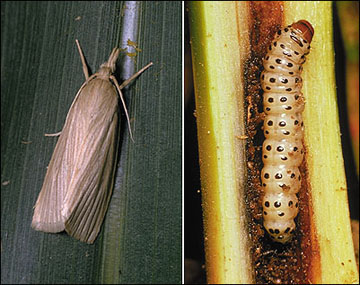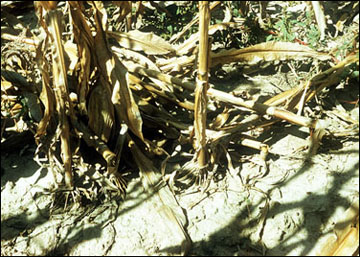The Diatraea grandiosella Dyar, is a pest of corn, Zea mays (Linné).
Description and life cycle
This insect overwinters as a full-grown larva at the base of the corn stalk. The dull white moths with their prominent, snoutlike mouthparts (Figure 1, left) do not feed and prefer to rest during daylight hours on corn plants or border vegetation. After female moths emerge and mate in mid- to late May, they lay their eggs singly or in small masses (3 to 5 eggs per mass) at night. Eggs are usually deposited on the upper leaf surface, and the eggs of the second generation are deposited at the ear zone or a node above or below the ear. A female moth is capable of laying 100 to 400 eggs in her short lifespan (approximately 5 days). Eggs are initially creamy white but develop three red transverse bars within 36 hours of being laid, and these bars remain until the larva's emergence (approximately 5 days).
Southwestern corn borer larvae initially have a reddish color but develop the characteristic off-white coloration and black spots by the second- or third-instar stage (Figure 1, right). Four to six weeks are needed for the southwestern corn borer to complete its development from the egg to adult stage. Full-grown larvae (1 to 1 1/4 inches in length) pupate within the stalk, and those of the second or third generation tunnel down (late August to early October in southeastern Missouri) into the base of the corn stalk to hibernate. These larvae (pale yellow with no spots) eventually construct a hibernation cell close (within 6 inches) to the soil surface.
 Figure 1
Figure 1
Southwestern corn borer moth, left, and larva, right.
Armon Keaster photo
Lee Jenkins Slide Collection
Table 1
Approximate timing for southwestern corn borer infestations in Missouri
| Pre-infestation | First generation | Second generation | Third generation girdling damage | Post-infestation |
|---|---|---|---|---|
| January to May | June | July | August to September | October to December |
Unlike the European corn borer, Ostrinia nubilalis Hübner, the southwestern corn borer has a limited number of alternate host plants, both cultivated and wild (primarily grass species). Corn is the preferred host because its foliage is attractive for egg-laying sites, and the corn's leaf and stalk tissues permit rapid larval growth. Other host plants in Missouri include milo, Sorghum bicolor, and johnsongrass, S. halepense. Although these alternate hosts can sustain injury, they are more important as reservoirs and overwintering sites for later southwestern corn borer infestations in corn.
Damage
First-generation southwestern corn borer larvae initially feed on succulent tissues within the corn whorl. As the damaged leaves unfurl they have a shot-hole appearance, but the most severe injury occurs when the terminal bud is fed upon. These plants later become stunted and bushy with the growth of numerous lateral buds once the terminal bud is destroyed ("dead heart"). Once larvae are half grown, they begin boring into the stalk.
Feeding damage by second-generation larvae typically starts as the corn tassels emerge. The small larvae may feed on the cobs, husks, shanks, leaf sheaths or ear kernels. In field corn, substantial plant injury occurs when half-grown or larger larvae of both the second and third generations bore into the stalk. Before the corn's internodes are fully elongated, stalk feeding by the southwestern corn borer can stunt the plant's growth. As these stunted plants mature, this stalk damage can decrease movement of nutrients to the ears and reduce yields. Later, as the larvae enter their winter hibernation phase, they cause additional damage when they girdle the stalk (Figure 2). This damage leads to lodging and interferes with harvesting practices.
 Figure 2
Figure 2
Southwestern corn borer lodging damage.
Scouting procedures and techniques
Once moths have been detected (usually late May or early June) in light traps or pheromone-baited traps, cornfields should be scouted on a weekly basis. Closely monitor fields for first-generation southwestern corn borer infestations during the whorl stage. Typically, southwestern corn borer larvae will feed for 11 to 14 days in the inner whorl before boring into the stalk. Windowpane damage (parallel strips adjacent to the leaf veins) to the foliage also is more extensive at this time. Later in the season, southwestern corn borer larvae feed on both ear and leaf sheath tissues after corn plants enter the tasseling stage. After feeding for about 11 days, larvae begin boring into the stalks. The most common site of entry is between the leaf sheath and stalk on the lower half of the plant.
Management
Early-planted corn (before May 1) usually escapes significant girdling damage, and insecticides generally are not needed
But when trap and field counts detect significant infestations of first generation southwestern corn borers, insecticides should be applied a week before the larvae begin boring into the stalk (usually within 12 to 14 days after hatching). The Missouri economic threshold for first-generation southwestern corn borer is either 25 percent of the plants infested with egg masses or the presence of larvae and whorl damage, or both. To control first-generation southwestern corn borer infestations, use granular (versus liquid) insecticide formulations. When directed over the row and down into the whorl of the plant, these granular formulations may provide longer residual control during this stage of the plant's growth. For the second- and third-generation southwestern corn borer infestations, the economic threshold also is 25 percent of the plants infested with eggs or the presence of larvae. Early detection of these infestations is crucial because the larger plant canopy hinders insecticidal control.
Early harvesting to limit southwestern corn borer girdling damage is a good management strategy, and specifically during years of unusually high southwestern corn borer infestations. Once corn plants are girdled, the corn stalks are more likely to break during windy conditions. These lodged plants are extremely difficult and time consuming to recover during harvest.
Original authors: Michael L. Boyd and Wayne C. Bailey
State Extension Entomology Specialists
The authors wish to thank G. Michael Chippendale (Professor, MU Department of Entomology) and Armon J. Keaster (Professor Emeritus, MU Department of Entomology) for their comments and suggestions of earlier drafts of this publication. We also wish to recognize their many years of research on southwestern corn borer biology and management, and their service to MU and Missouri corn producers.